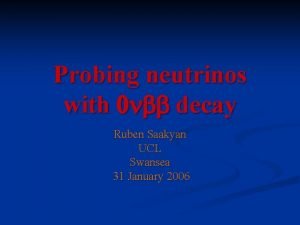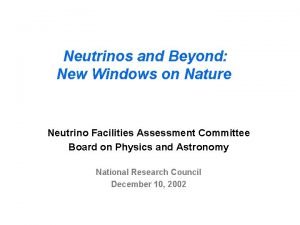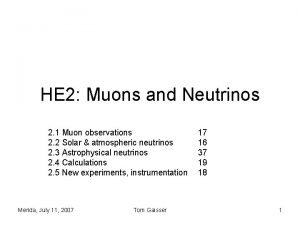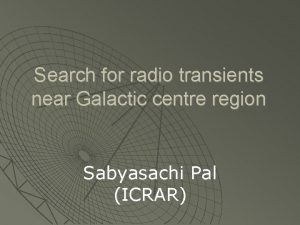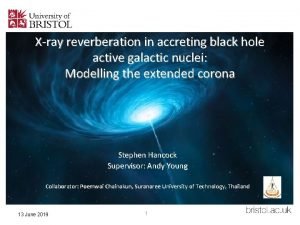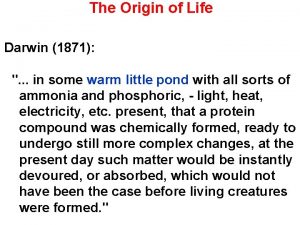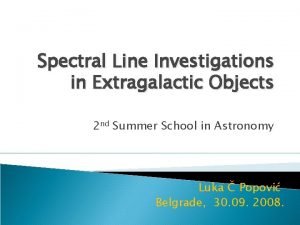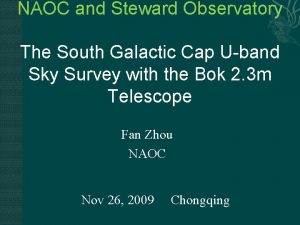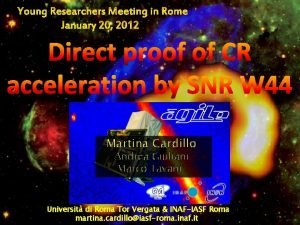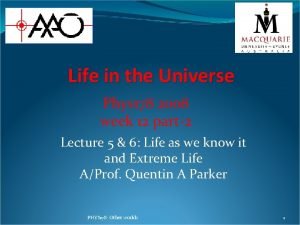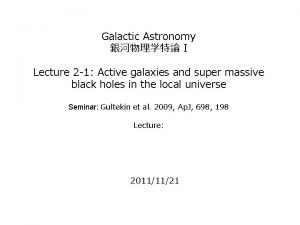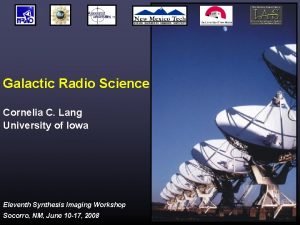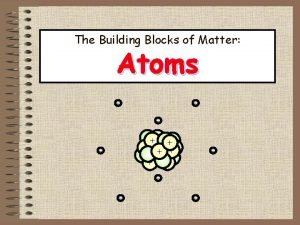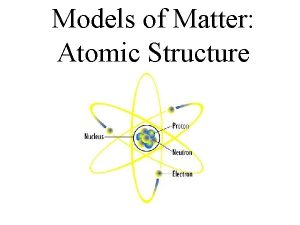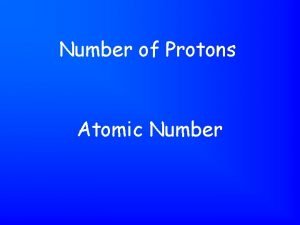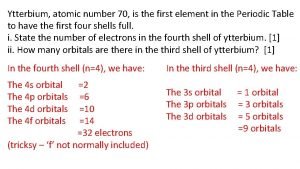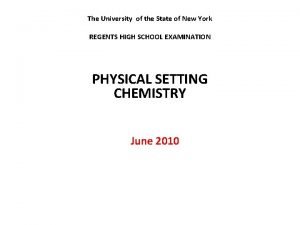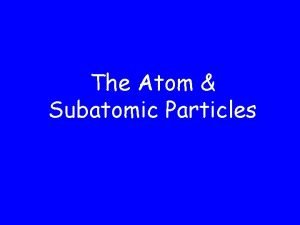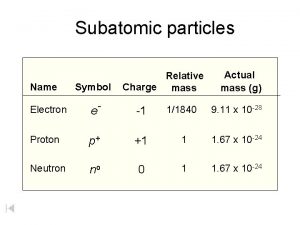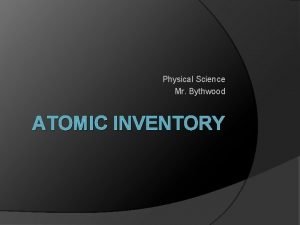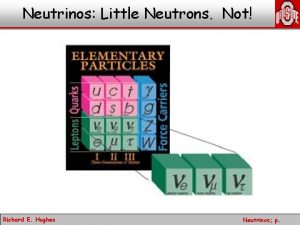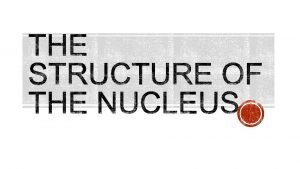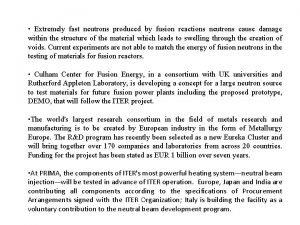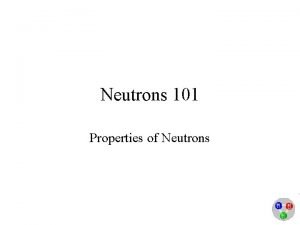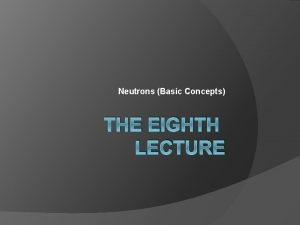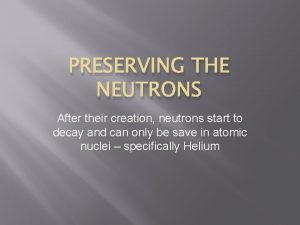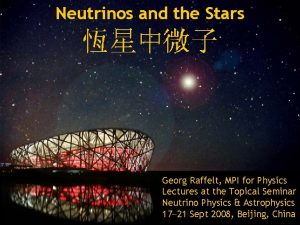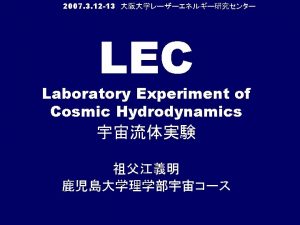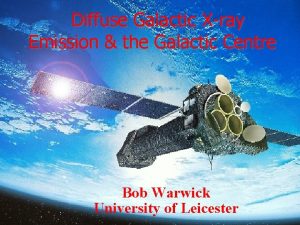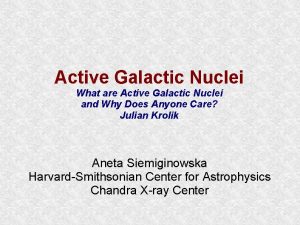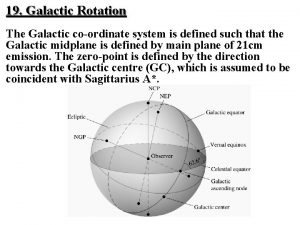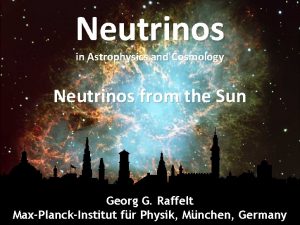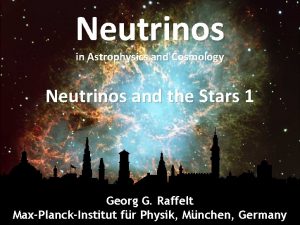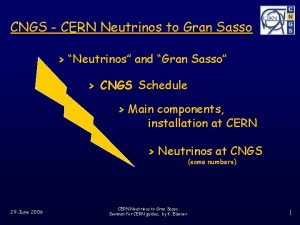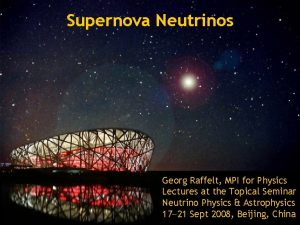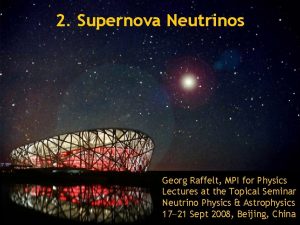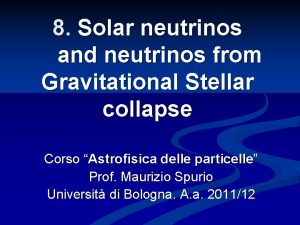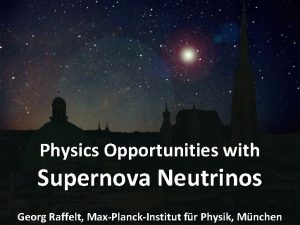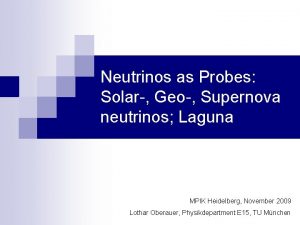Neutrons and Neutrinos from the Galactic Center The






























- Slides: 30

Neutrons (and Neutrinos) from the Galactic Center The AGASA/SUGAR EHE cosmic ray anisotropies and Te. V gamma rays Roland Crocker Harvard-Smithsonian Cf. A Aspen, 2005

References: (i) Ap. J 622, 892 (2005) (ii) Ap. JL 622, L 37 (2005) Collaborators: Marco Fatuzzo, Xavier University Randy Jokipii and Fulvio Melia, University of Arizona Ray Volkas, University of Melbourne 2

Introduction • AGASA and SUGAR see an overabundance of cosmic rays towards the Galactic Center (GC) at extremely high energies (EHE), ~1018 e. V • This anisotropy is observed to “turn on” and then “turn off” at welldefined energies • A natural explanation of this phenomenon is that it is due to neutrons generated at the GC: the Lorentz-boosted decay length of the neutron becomes equal to the distance to the GC at precisely the energy at which the anisotropy turns on – i. e. , a neutron at 1018 e. V experiences a quarter of an hour in its propagation from the GC • By relating gamma-ray observations of the GC with the CR anisotropy data we have investigated – and found plausible - a conventional astrophysical explanation for the production of these putative EHE neutrons: that they are produced in proton-proton collisions at the supernova remnant Sgr A East located near the GC • This research very tentatively identifies a definite Galactic object as a strong source of cosmic rays between the knee and the ankle 3

Evidence for EHE CR Anisotropy • AGASA – Japanese, giant air-shower array – finds anisotropy (~25 % overabundance) at the 4 σ level towards the GC over a 20 degree diameter circle for 17. 9 < log[ E/e. V ] < 18. 3 Data taken over a 20 year period and amount to 200 000 >1017 e. V CR showers – Hayashida et al. 1999. • Re-analysis of SUGAR data (1968 -1979) also uncovers point source near GC (4000 events within a priori restricted energy range) – Bellido et al. 2001. • New AGASA data strengthens case for anisotropy: get 4. 5 σ result for 18. 0 < log[ E/e. V ] < 18. 4 • AGASA also sees enhancement towards Cygnus (3 σ effect) and a deficit towards the Galactic anti-center (3. 7 σ effect) • Fly’s Eye: Galactic Plane enhancement at 3. 2 σ (Bird et al. 1999) for 17. 3 < log[ E/e. V ] < 18. 5 BUT Hi. Res: data consistent with isotropic source model for log[ E/e. V ] > 18. 5 (Stokes et al. 2004) - does not exclude the AGASA GC anisotropy result • 4

AGASA CR Sky Galactic Plane Hayashida et al. 1999 5 Instrument horizon

Issues • AGASA cannot see GC directly (below instrument horizon) • SUGAR can see GC but their point source off-set from GC by 7. 5 +/- 3. 0 degrees • SUGAR “source” in field of view of AGASA – should be seen by AGASA but is not • No particularly compelling astrophysical object in direction of SUGAR source (though close to Galactic Plane) • We proceed under the hypothesis that the SUGAR directional determination is in error 6

Modeling of GC CR Propagation • Bossa et al. J. Phys. G. 29, 1409 (2003): successfully reproduce broad features of observed anisotropies with assumed, GC pointsource of n’s governed by spectral index of 2. 2 • Model combined signal from neutrons and neutron-decay protons (latter’s paths bent in Galactic B fields forming a “halo” around the point source) – n’s and p’s indistinguishable at these energies. • Anisotropy becomes increasingly point-like with increasing energy (until all remain neutrons after propagation) • Neat explanation of disappearance of AGASA anisotropy at certain energy: get point source below horizon • AGASA and SUGAR fluxes consistent with each other in n decay picture given AGASA is seeing the halo p’s and SUGAR the n point source 7

EHE Neutron Production • Three basic HE n production scenarios: 1. Dissociation (on target photons or p’s) of heavy ions into component p’s and n’s 2. Charge exchange in p-γ : pγ→n. X 3. Charge exchange in p-p: pp→n. X • In the above X is mostly pions (10’s thereof in p p, significantly fewer in p γ ) 8

Identifying the Neutron Source Process • Dissociation may operate, but no attendant Ge. VTe. V photon signal (cannot normalize) • p-gamma: not effective until Ep > 1018 e. V (when NIR photons above threshold) and, even then, GC has too small an ambient density of photon targets • p-p best bet: charge exchange can occur for Ep>Ge. V and many target p’s…associated pions decay to produce a concomitant gamma-ray signal 9

Multiplicity and Inelasticity of Charge Exchange • From experiments conducted at CERN (ISR) and Fermilab in 70’s: (i) Occurs in ~40 % p-p interactions, i. e. , (leading) neutron multiplicity of 0. 4 (ii) Neutron gets about 25 % of incoming proton’s energy, i. e. , leading neutron elasticity is 0. 25 • Data on multiplicity and elasticity are at much lower E_CMS energies than we require (60 Ge. V rather than 60 Te. V) – cf. p-γ interaction… • →Require modeling. This indicates that these fractions are approximately energy-independent 10

p-p Cross-section • • p-p cross-section at relevant energies (s~60 Te. V) extracted from cosmic ray data scaling-violating but slow growth of the total p-p cross-section [from ~40 mb to 120 mb over the energy span of concern] 11

Spectrum-weighted moments • SWMs relate emissivity in daughter particles (n’s or γ’s) to the number [/s/cm 3/e. V] of interacting parent particles [p’s] where Feynman scaling holds • For power-law parent distribution daughter particles have same distribution with same spectral index (in scaling regime) • Have also allowed for: (i) growth of the total p-p cross-section (ii) exponential cut-off in parent p distribution 12

Gamma Rays: Independent Evidence for p-p Interactions at GC • GC gamma ray signal seen at both ~Ge. V (EGRET) and ~Te. V energies (Whipple, CANGAROO, HESS) • This signal convincingly ascribed to neutral pion decay from p-p interactions • Gamma ray signal supports existence of population of HE, shock-accelerated p’s 13

Predicting the Neutron Flux from the Gamma-ray Signal (i) normalization supplied by the (p-p) gamma-ray signal + (ii) expectation from shock acceleration theory + (iii) particle physics [spectrum-weighted moments with slow cross-section growth, constant multiplicity and inelasticity] = predict the expected (p-p) neutron flux at EHE …provided the parent p population extends to ~1019 e. V 14

Gamma-ray and n Signals Compatible… • With a spectral index (in agreement with that supplied by observation and in good agreement with expectation from acceleration at a strong shock) of 2. 2 -2. 3 the (Ge. V) EGRET gamma-ray signal predicts the right neutron flux – at 9 orders of magnitude higher in energy • The (Te. V) HESS signal with a spectral index of 2. 0 is also compatible with the n signal 15

Chi-squared Fitting to Combined Data: EGRET Best-fit spec. ind. = 2. 23 chi^2/dof = 0. 33/(4 -2) = 0. 17 16

Chi-squared Fitting to Combined Data: HESS Spec. ind. = 2. 0 (set) chi^2/dof = 5/(11 -1) = 0. 5 17

Considerations • How might p’s be accelerated to such high energies? • Total power requirements • HESS and EGRET apparently incompatible: EGRET “predicts” much larger ~Te. V (20 x) flux than seen by HESS • CANGAROO and HESS incompatible • Whipple and HESS incompatible Re-analysis reveals compatible • (No evidence for variability from any one instrument, only between instruments) 18

Total Power • EGRET – EHECR normalization: ~4 1038 erg/s in interacting p’s → 1. 3 1050 erg over 104 years • HESS – EHECR normalization: ~4 1036 erg/s in interacting p’s → 1. 3 1048 erg over 104 years 19

Te. V GC Observations: position determinations by various instruments • Position of Te. V GC source overlaid on 21 cm radio map • Bright spot in HESS confidence region is Sgr A* • Sgr A East is ring like feature to East of Sgr A* • The HESS source is inside the CANGAROO field of view Gal East ~25 pc Gal West 20 (Horns, astro-ph/0408192)

Te. V and Ge. V GC Fluxes (various instruments) Figure and HESS data from Aharonian et al. 2004 CANGAROO HESS Now revised downwards 21

Possible resolutions of EGRET-HESS “disagreement” 1. Energy-independent mis-calibration of one or more instruments? Possibility – certainly big problems in observing noisy regions like the GC at ~Te. V energies - but EGRET predicts 20 x HESS flux at ~Te. V 2. Pair production on NIR-optical (~1 e. V) photons attenuating Te. V+ photons (cf. some X-ray binaries)? Can get effectively energy-independent attenuation of photons, but photon column density too small given low emission of GC (cf. other galactic nuclei) 3. Two effective sources? Definitely plausible (i) evidence that EGRET and HESS sources angularly-separated – Hooper and Dingus (astro-ph/0212509) find EGRET source center of gravity ~12 arcminutes from the GC, whereas the HESS source lies within 1 arcminute of the GC. Pohl (astro-ph/0412603) confirms offset (ii) in SNR population flux level and energy cut-off observed to go in opposite directions (ambient particle density) but (i) does not explain very similar spectral indices in Fit 1 (ii) requires 7 orders magnitude difference in maximum energies at two sites (EGRET source must cut-off not to pollute HESS signal) 22

Plausible Sources of EHE n’s: 1. Sgr A* • Sgr A* - shock(s) in the accretion disk surrounding the supermassive (~3 M solar mass) BH at the GC (@ 40 -120 R_Schwz) Obvious choice, but (i) previous modeling (Markoff et al. 1999) determined max E_p to be 4 x 1017 e. V (given maximum shock size and magnetic field)– i. e. , too low to produce n signal (ii) synchrotron emissivity of secondary leptons in inferred 10 G+ fields near central BH would far exceed Sgr A*’s observed radio flux (iii) lack of variability seen in ~Ge. V and ~Te. V data tells against compact source (iv) inefficient – most p’s escape → tough energy demand 23

Plausible Sources of EHE n’s: 2. Sgr A East • Sgr A East: SNR located close (shell located from 10 pc to within 1 pc) to GC • Good evidence for association with EGRET GC source (3 EG J 1746 -2851) → gamma-ray luminosity 2 orders of magnitude larger than other EGRETdetected SNRs…Why? …near GC, find unusually-high (i) magnetic field strengths of O[m. G] (ii) ambient particle densities of ≥ 104 /cc (105 - 106 /cc molecular clouds) 24

Unusually High Maximum p Energies at Sgr A East • With 4 m. G field Sgr A East shock can accelerate particles to 1019 (R/10 pc) Z e. V in a perpendicular shock configuration (Jokipii 1982 & Ap. J 1987) • p-p cooling-limited p energy is ~1021 e. V • Time-limited p energy is ~1020 e. V (given 10 000 year age) 25

Sgr A East and the Two Source Model • Natural fit: Sgr A East shell subtends regions of widely varying particle density and magnetic field strength (and orientation) • EGRET source: 0. 1 m. G field to accelerate p’s and create secondary leptons which then gyrate to produce observed radio emission (6 and 20 cm) – self-consistent • HESS source: 4 m. G field required to produce radio signal – good match with field required to produce required 1019 e. V p’s for n production (Fatuzzo and Melia 2004) and also good match with direct polarimeter measurements of GC field (Chuss et al. 2003) 26

Extension: GC Neutrino Flux • Substantial neutrino flux from GC pion, muon decay which can be normalized to gamma-ray and neutron signals (β-decay anti-nue’s insignificant) • Signal should be visible in future Northern Hemisphere km 3 neutrino detectors (within 1. 5 years for HESS normalization case) in numuinduced muons • Signal should also be visible to Ice. Cube detector (within 1. 6 years for HESS normalization case) in down-going nue and nutau-induced showers • HE neutrinos → can also detect through Glashow process: anti-nue + e- → W- in Ice. Cube 27

Summary • From the observed anisotropy in the EHE CR spectrum, there appear to be n’s coming from the GC • These n’s can be explained as arising from charge exchange in p-p interactions • We have shown that conventional astrophysics can explain the n’s (and, therefore, the anisotropy): shock acceleration in the unusual SNR Sgr A East can produce the required population of extremely energetic p’s provided a perpendicular shock geometry is realized • The GC gamma-ray signals are fully compatible with – in fact, predict – the EHE n flux required to explain the EHE CR anisotropy, but they are not (simply) compatible with 28 each other

The Future • Auger – first Southern Hemisphere extensive air shower array since SUGAR. Promises massive increase in EHE CR data down to ~1018 e. V. Should see strong, GC point source of CRs and halo. Will either confirm or rule-out our scenario. • GLAST – should establish definitively which GC object is supplying the ~Ge. V gamma-rays seen by EGRET. • Need continued monitoring of GC with air Cerenkov telescopes at ~Te. V energies with Whipple, HESS, and CANGAROO…results from 29 Whipple upgrade (VERITAS) eagerly awaited.

Continuing Work • What about the p’s that get away? Could the GC actually be a dominant CR source in a restricted energy regime above the knee? • How to explain why the accelerated p population at the HESS source extends up to ~1019 e. V, whereas the EGRET p population only extends to ~ 1011 e. V ? – importance of diffusion? • Contrasting nu signal from our scenario with that due to DM decay at GC 30
 Neutrinos
Neutrinos Neutrinos
Neutrinos Neutrinos
Neutrinos Galactic center radio transients
Galactic center radio transients Glorck
Glorck Hoyt sector model
Hoyt sector model Swcombine factions
Swcombine factions All three models of urban structure
All three models of urban structure Urban realms model
Urban realms model Active galactic nuclei
Active galactic nuclei Galactic habitable zone
Galactic habitable zone Active galactic nuclei
Active galactic nuclei Galactic phonics ure
Galactic phonics ure Galactic cap review
Galactic cap review Alessandro cardillo
Alessandro cardillo Galactic habitable zone
Galactic habitable zone Active galactic nuclei
Active galactic nuclei Galactic
Galactic Protons and neutrons size
Protons and neutrons size Gold number of neutrons
Gold number of neutrons Lithium number of protons and neutrons
Lithium number of protons and neutrons Sulfur number of neutrons protons and electrons
Sulfur number of neutrons protons and electrons Element scavenger hunt answer key
Element scavenger hunt answer key 15n protons neutrons electrons
15n protons neutrons electrons Ytterbium number of protons
Ytterbium number of protons Period 3 nonmetal 32 amu
Period 3 nonmetal 32 amu Arrangement of subatomic particles
Arrangement of subatomic particles Which equation represents sublimation?
Which equation represents sublimation? U 238 protons neutrons electrons
U 238 protons neutrons electrons Symbols for subatomic particles
Symbols for subatomic particles Mass of protons neutrons electrons
Mass of protons neutrons electrons
